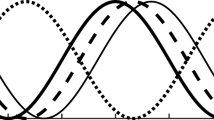Abstract
The quality of side information has an important impact on the performance of a distributed video coding system. At present, the generation of side information is mainly based on the translational motion model using the inter-frame correlation for motion estimation. Considering that the generated side information is prone to block effect and ghosting, as well as the situation that the nonlinear motion is not fully considered and the intra-frame correlation is not fully utilized, a side information hybrid generation algorithm based on an improvement model for the motion vector field is proposed. The side information frame to be generated for the current Wyner-Ziv frame is divided into easy-to-estimate and difficult-to-estimate macroblocks. For difficult-to-estimate macroblocks, the Horn and Schunck dense optical flow method is used to generate reliable motion vectors, for easy-to-estimate macroblocks, the block matching method is used to generate unreliable motion vectors which are modified by the proposed scheme, and then, the improved motion vectors are used for motion compensation to produce the final side information frame. Experiment results show that the quality of side information obtained by using the improved motion vector field for motion compensation has been significantly improved, thus the overall performance of the distributed video coding system has been effectively improved.









Similar content being viewed by others
References
Aaron A, Zhang R, Girod B (2002) Wyner-Ziv coding of motion video. In: the Thirty-Sixth Asilomar conference on signals, systems and computers, pp 240–244
Artigas X, Ascenso J, Dalai M, Klomp S, Kubasov D, Ouaret M (2007) The DISCOVER codec: Architecture, Techniques and Evaluation. In: Picture coding symposium
Ascenso J, Brites C, Pereira F (2005) Improving frame interpolation with spatial motion smoothing for pixel domain distributed video coding. In: 5th EURASIP Conference on Speech and Image Processing, Multimedia Communications and Services, pp 1–6
Benierbah S, Khamadja M (2020) Symbol positions-based Slepian-wolf coding with application to distributed video coding. IET Image Proc 14(11):2301–2309
Bouguet J-Y (2001) Pyramidal implementation of the affine lucas kanade feature tracker description of the algorithm. Intel Corp 5:1–10
Cao Y, Sun L, Han C, Guo J (2017) Improved side information generation algorithm based on naive Bayesian theory for distributed video coding. IET Image Process 12(3):354–360
Chen J, Zheng S, Hu Q, Kuo Y (2017) A frame-level encoder rate control scheme for transform domain Wyner-Ziv video coding. Multimed Tools Appl 76(20):20567–20585
Dash B, Rup S, Mohapatra A, Majhi B, Swamy MN (2018) Decoder driven side information generation using ensemble of MLP networks for distributed video coding. Multimed Tools Appl 77(12):15221–15250
Girod B, Aaron A, Rane S, Rebollo-Monedero D (2005) Distributed video coding. In: Proc. IEEE, pp 71–83
Goloubentsev AF, Anikin VM, Noyanova SA, Barulina YA (2003) Baker transformation as autoregression system. In: IEEE international symposium on workload characterization
Horn BKP, Schunck BG (1980) Determining optical flow. Artif Intell 17(1–3):185–203
Imran N, Seet B, Fong AC (2015) Distributed video coding for wireless video sensor networks: a review of the state-of-the-art architectures. SpringerPlus 4(1):513–513
Jun D (2019) Distributed video coding with adaptive two-step side information generation for smart and interactive media. Displays 59:21–27
Kuo Y, Gao P, Chen J (2016) Distributed video coding with limited feedback requests. Multimedia Tools Applications 75(4):2051–2065
Li X (2007) Video processing via implicit and mixture motion models. IEEE Trans Circuits Syst Video Technol 17(8):953–963
Liu H, Zhao B, Huang L (2019) Quantum image encryption scheme using arnold transform and S-box scrambling. Entropy 21(4):343
Liveris AD, Xiong Z, Georghiades CN (2002) Compression of binary sources with side information at the decoder using LDPC codes. IEEE Commun Lett 6(10):440–442
Shen YC, Cheng HP, Luo JC, Lin YH, Wu JL (2017) Efficient real-time distributed video coding by parallel progressive side information regeneration. IEEE Sens J 17(6):1872–1883
Slepian D, Wolf JK (1973) Noiseless coding of correlated information sources. IEEE Trans Inf Theory 19(4):471–480
Sushma B, Aparna P (2020) Distributed video coding based on classification of frequency bands with block texture conditioned key frame encoder for wireless capsule endoscopy. Biomed Signal Process Control 60:101940
Taheri YM, Ahmad MO, Swamy MN (2018) A joint correlation noise estimation and decoding algorithm for distributed video coding. Multimed Tools Appl 77(6):7327–7355
Taheri YM, Ahmad MO, Swamy MN (2019) Successive refinement of side information frames in distributed video coding. Multimed Tools Appl 78(15):20697–20722
Wyner A, Ziv J (1976) The rate-distortion function for source coding with side information at the decoder. IEEE Trans Inf Theory 22(1):1–10
Xiong Z, Liveris AD, Cheng S (2004) Distributed source coding for sensor networks. IEEE Signal Process Mag 21(5):80–94
Zhang Y, Zhao D, Liu H, Li Y, Ma S, Gao W (2012) Side information generation with auto regressive model for low-delay distributed video coding. J Vis Commun Image Represent 23(1):229–236
Acknowledgements
This work was supported by the National Natural Science Foundation of China under Grant 61861045.
Author information
Authors and Affiliations
Corresponding author
Additional information
Publisher’s note
Springer Nature remains neutral with regard to jurisdictional claims in published maps and institutional affiliations.
Rights and permissions
About this article
Cite this article
Wang, W., Li, J., Mo, H. et al. Side information hybrid generation based on improved motion vector field. Multimed Tools Appl 80, 26713–26730 (2021). https://doi.org/10.1007/s11042-021-10870-8
Received:
Revised:
Accepted:
Published:
Issue Date:
DOI: https://doi.org/10.1007/s11042-021-10870-8




